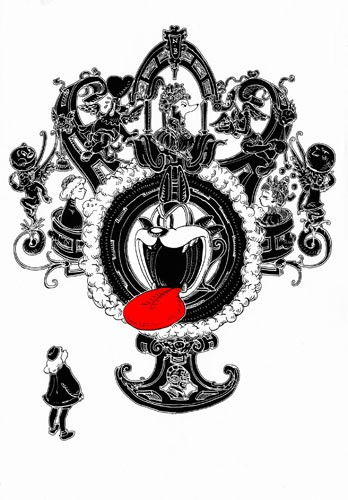
Artist’s concept, 2014 ⒸNicolas Buffe
The Hara Museum is proud to present the first solo exhibition at a museum by the rising French artist Nicolas Buffe. Born in Paris and currently based in Tokyo, Buffe creates art that is grand and yet lighthearted, whose influences range from Renaissance grotesques and Baroque ornament to American and Japanese sub-cultures such as manga, anime and video games. His fusion of Eastern and Western traditions both classical and modern has been garnering attention not only within art circles, but also in areas as diverse as opera and fashion.
This exhibition pays homage to the Hypnerotomachia Poliphili (1), a book published in Venice in 1499. During his first encounter with the book, Buffe was struck by the structural similarity between the story of Polifilo and the initiation quests that he experienced in video games such as Legend of Zelda, Super Mario Bros and Final Fantasy. Like the book, this exhibition comprises an allegorical dream in which the hero (the visitor) must make it through several stages of an adventure during which he encounters magical objects and images, makes discoveries, plays games and even engages in interactive play through the magic of Augmented Reality (AR) (2). Buffe plays on the architectural characteristics of the museum to transform all of its spaces into a wonderland.
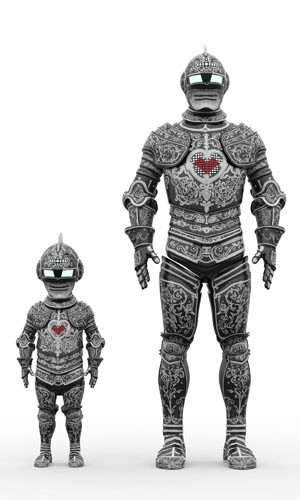
Study for installation, 2014 ⒸNicolas Buffe
Notes:
1. Hypnerotomachia Poliphili: Translated into English as Poliphilo’s Strife of Love in a Dream, this book is the story of Poliphilo who pursues his true love Polia through a dreamlike landscape. The title Hypnerotomachia comes from the Greek hýpnos for “dream,” éros for “love,” and máchē for “battle.”
2. AR: Augmented Reality. An enhanced version of reality produced by the overlaying of digital information onto image data from a camera.
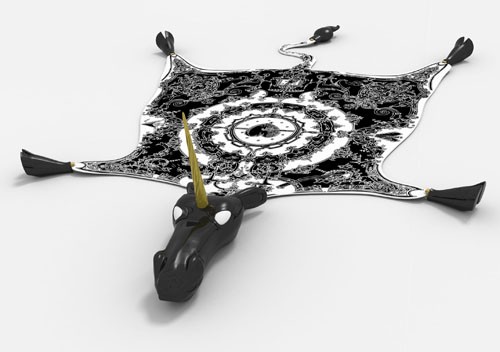
Peau de licorne (Unicorn Pelt), 2010, Weaving project for Cité internationale de la tapisserie et de l’art tissé, Musée de la tapisserie d’Aubusson ⒸNicolas Buffe

Artist’s rendition of finished installation ⒸNicolas Buffe
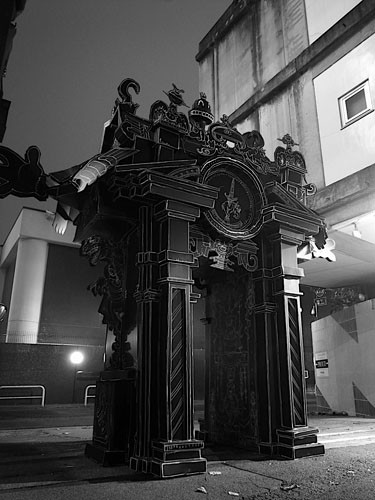
No Man’s Land Gate, 2009 (exhibition view), No Man’s Land exhibition at the former French Embassy in Japan
ⒸNicolas Buffe (Supplementary Image)
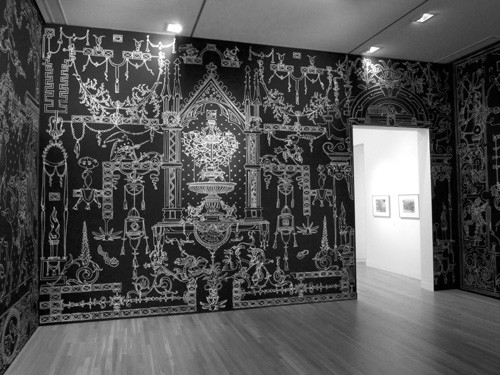
Golden Age, 2008 (exhibition view), Okujô Teien – Roof Gardens, Museum of Contemporary Art, Tokyo ⒸNicolas Buffe (Supplementary Image)
Who Is Nicolas Buffe?
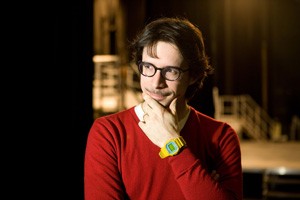
Photo by Antoine Piechaud – Théâtre du Châtelet
Born in Paris in 1978, Nicolas Buffe grew up watching Space Sheriff Gavan (1) and other live-action special-effects programs, not knowing at the time that they were originally made in Japan. This fact would later spark an intense interest in the country that led him to study the language and culture, and to subsequently move to Tokyo where he is currently based. For Buffe, love and aspiration, struggle and victory, life and death are universal themes that lie at heart not only of classical European art, but of Japanese anime, manga and live-action superhero programs as well. About his work, Buffe has called it “a navigation within an anachronical network of cultural and historical references drawn from both classical culture and pop culture, especially those that influenced me during my childhood.” In his recent doctoral thesis (2), he identifies diversity, cultural wandering and connections as the three main themes of his work, characteristics that distinguish art of the Altermodern era (3) as defined by Nicolas Bourriaud, curator and director of the École Nationale Supérieure des Beaux-Arts. His work has appeared at several venues within Japan, including a solo exhibition at the Ginza Maison Hermès in Tokyo (Little Red Riding Hood “Carré”, 2010), a triumphal arch at the entrance to the previous French Embassy, Tokyo (No Man’s Land, 2009), and a group exhibition at the Museum of Contemporary Art, Tokyo (Okujô Teien – Roof Gardens, 2009). In Europe, Buffe referenced American and Japanese sub-cultures and classical European aesthetics in his costume and stage design for the opera Orlando Paladino staged at the Théâtre du Châtelet in Paris in 2012, for which he became an overnight sensation and won the award for Best Scenic Design from the French Critics Association.
Notes:
1. Space Sheriff Gavan (Uchū Keiji Gyaban): a Toei series that was broadcast on TV Asahi from March 5, 1982 through February 25, 1983.
2. Thesis title: Orutamodan jidai no naka de jibun no maniera wo tsukurukoto no shiko (the making of a personal maniera in the age of the altermodern)
3. Altermodern: A word coined by Nicolas Bourriaud to describe the era following the end of post-modernism in the first decade of the 21st century.
Artist Profile
Born in Paris in 1978. Lives and works in Tokyo.
2014 Ph.D Intermedia Art, Tokyo University of the Arts (Tokyo Geijutsu Daigaku)
2011 M.A. Intermedia Art, Tokyo University of the Arts (Tokyo Geijutsu Daigaku)
2007 Licence in Japanese Language and Civilization Studies, Institut National des Langues et Civilisations Orientales (INALCO), Paris
2005 DNSAP, École Nationale Superieure des Beaux-Arts (Ensba), Paris (National School of Fine Arts)
2000 BTS, architectural environment design, École Nationale Supérieure des Arts-Appliques et des Metiers d′Arts (ENSAAMA), Olivier de Serres, Paris
2012 Scenography, costume design and visual conception for the opera ORLANDO PALADINO at Théâtre du Châtelet, Paris, France
2010 Little Red Riding Hood “Carré” (window display), Maison Hermès, Tokyo
2010 La Tour, Megumi Ogita Gallery, Tokyo
2009 – 2010 No Man’s Land, former French Embassy in Japan, Tokyo
2009 Wall drawing for the reception room at the new French Embassy in Tokyo, Japan
2008 Okujô Teien – Roof Gardens, Museum of Contemporary Art, Tokyo
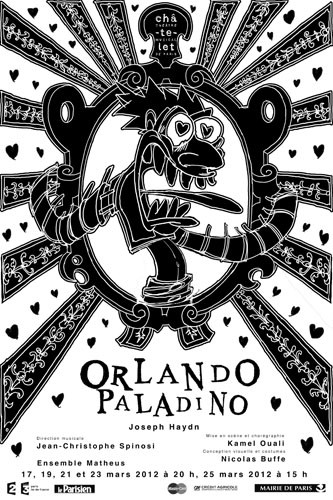
Poster for Orlando Paladino, 2012 ⒸNicolas Buffe
Exhibition Details
Title: Nicolas Buffe, The Dream of Polifilo
Dates: April 19 (Saturday) – June 29 (Sunday), 2014
Venue: Hara Museum of Contemporary Art 4-7-25 Kitashinagawa, Shinagawa-ku, Tokyo 140-0001
Tel: 03-3445-0651 E-mail: info@haramuseum.or.jp Website: http://www.haramuseum.or.jp
Mobile site: http://mobile.haramuseum.or.jp Blog: https://www.art-it.asia/en/u/HaraMuseum_e
Twitter: http://twitter.com/haramuseum (in Japanese only / account name: @haramuseum)
Organized by: Hara Museum of Contemporary Art
Supported by: Embassy of France/Institut français du Japon, Institut français Paris, Centre national du cinéma et de l’image animée – DICRéAM, Fondation Nationale des Arts Graphiques et Plastiques, Fondation Franco-Japonaise Sasakawa
Special sponsorship by: Hermès Japon Co., Ltd.
Sponsored by: Societe Generale, Vranken Pommery Japan, LM3LABS
Corporation provided by: YAMAMOTO GENDAI
Hours: 11:00 am – 5:00 pm, Wednesdays until 8:00 pm (last entry 30 minutes before closing)
Closed: Mondays (open on May 5), May 7
Admission: General 1,100 yen; Students 700 yen (high school and university) or 500 yen (elementary and junior high); Free for Hara Museum members, students through high school every Saturday during the school term; 100 yen discount per person for groups of 20 or more
* The admission fee has been revised to reflect the rise in consumption tax effective April 1, 2014.
Directions: 5 minutes by taxi or 15 minutes on foot from JR Shinagawa Station (Takanawa exit); or from the same station take the No.96 bus, get off at the first stop (Gotenyama), and walk 3 minutes
Related Events
Details will be announced on our website.
——————————————————————
Note regarding Photography
By special permission of Nicolas Buffe, visitors will be allowed to photograph works by the artist under the following restrictions:
■While taking photos, take care not to bump into or touch the artwork.
■Flash photography is not permitted.
■Close-up photography is not permitted.
■Video recording is not allowed.
■Tripod use is not allowed.
■Out of concern for personal privacy, please refrain from photographing other visitors.
■Please observe proper etiquette while taking photos.
■Photos taken are for private use only. Use for commercial or other secondary purposes that infringe on copyright is prohibited.
■No photography is allowed of permanent installations identified by the“No Photography Allowed” sign.
■Please note that under crowded conditions, restrictions may be placed on photography.
